Spiny Mice
Spiny Mouse Housing
You should have your future pet's home (cage, tank...) perfectly ready before actually getting the pet to live there. At the very latest, you should buy the abode at the same time as your spiny mouse. Consider very carefully what kind of abode will suit best both your pet's and your needs. Getting a cage hastily may end up being costly if you find out that what you bought was unsuitable for your spiny mouse and you are forced to buy something else.
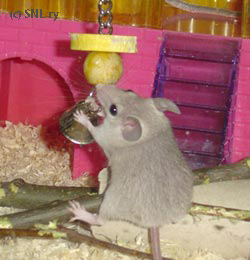
Young spiny mouse playing |
Home!
There are many kind of tanks being sold. It's up to you to choose the most suitable one. If you're good with handwork, you can construct a tank by yourself. The spiny mouse's abode should fill the following requirements:
1. It should be safe for the spiny mouse. There must not be anything in the
abode where they could hurt themselves.
2. It has to be escape proof. However, all lids or doors should be easy
to open and close (by you).
3. You have to be able to take your spiny mice out of their tank with
ease. Doors which are too small are very inconvenient.
4. The abode has to be easy to clean.
5. Feeding your spiny mice has to be easy.
6. There should be enough of ventilation.
7. There has to be enough room for the mice and their equipment.
8. The abode should last longer than an individual spiny mouse's life span.
Cage or tank?
Generally speaking, the topic should go: "Not a cage, a tank", as cages aren't recommended for spiny mice at all. So, the real alternatives are plastic and glass tanks. When choosing the abode, you should take into consideration the number, sex and species of your spiny mice and if there are other animals in your household - animals you have to keep away from your spinies. Furthermore, think closely what alternatives suit best in your home.
4-5 spiny mice can be housed in a 60 -litre terrarium, but for a single spiny mouse the terrarium shouldn't be much smaller.
Plastic tanks
There are all kinds and sizes of plastic tanks available from tiny show boxes to Ferplast Duna -boxes. "Habitrail" hamster homes with all kinds of different rooms and tubes can also be included in this section. When choosing a tank you should pay attention to the floor space available. The height is not that important (although the spiny mouse has to be able to stand up tall and preferably climb), but it is much easier to build additional floors and ladders to a higher tank.
Plastic tanks are light to move and easy to clean. Furthermore, they come with lids. You are able to put a large amount of beddings in a tank for the mice to play in and hide small cardboard boxes and tubes under the beddings.
However, the small plastic tanks are unsuitable for spiny mice as homes and if the tank is not high enough, the spinies can gnaw their way out through the lid. A determined mouse can even chew itself to freedom through the wall. With a tank you should make sure that sun does not shine in the tank - sunshine can raise the temperature in the tank to deadly hot. If the beddings get even a bit too dirty, the ammonia levels in the tank get so high it will damage the respiratory tracts of your mice. In the long run, the bottom of a plastic tank may get a bit stained from the mouse urine.
Glass tanks
Rather large, wider than high glass tank (usually former aquarium) is pretty suitable for spiny mice. Reptile tanks are not as suitable, as they often lack ventilation. A glass tank needs a wire mesh lid, escape proof and durable. Used glass tanks are usually easy to find for cheap prize, as a spiny mouse tank doesn't have to hold water. However, it should not have cracks.
Glass tanks have the good points of plastic tanks. Furthermore, they don't get stained and a mouse can't chew its way out.
However, glass tanks are rather heavy and especially the larger ones are too heavy to carry in the bathroom for wash ups. The dangers of plastic tanks are present with the glass ones as well; sunshine is dangerous and you have to remember to clean the beddings in time. Furthermore, a glass tank can get broken very easily, if you happen to drop it.
Beddings & Cleaning
Beddings or litter should not be forgotten! Good beddings are soft (so that the mouse can play in it) and as dust free as possible. From different wood chips aspen is safe. Do not use pine or cedar - these cause respiratory ailments! CareFresh and similar products are also safe, corn cob can get moldy fast and dry the air so much that it isn't good for the mice.
For nesting material you can give your mice high quality hay (green, not moldy or dusty), straw or shredded tissue paper. Do not get "hamster cotton" or similar fiber products. This has caused blockages in intestines, deaths by strangulation and amputations of limbs.
Cleaning up
You should clean up your spiny mouse's abode once or twice a week depending on the size of the abode and the number of animals in it. You should wash all your spiny mice's furniture with hot water once a week. Cleaning up is easier if you get two sets of everything to start with. This way one set is being used by your spiny mice, the other set can be cleansed thoroughly.
You can change the order of the spiny mice's toys while cleaning and hide little treats among the toys and beddings for your mouse to find. Spinies are active little animals and they love exploring their surrounding and changes in it.
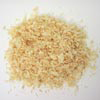

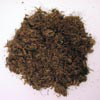
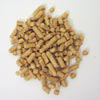
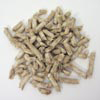
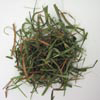
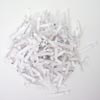 Beddings and litter suitable for spiny mice: Wood shavings, aspen chips, peat, wood pellets, paper pellets, hay and shredded paper. |
Spiny Mouse House Furnishing
A home without any furniture is pretty boring, isn't it! According to a scientific study, having plenty of things to play with makes mice smarter than those living in a boring environment. Most likely this goes for spiny mice as well! Now, you don't want to have a dumb pet, do you? So, give your pets lots of activities.
Food bowl and water bottle
Most important equipment are food bowl and water bottle. Make sure, that the water battle you buy actually works. There are huge differences between bottles from the same manufacturer. Some can't hold water at all, while some don't let any water out no matter how hard to poor spiny mouse tries to drink.
For a food bowl a ceramic cup will do, these are available from pet shops. There are also cheaper alternatives - small glass baby food jars as well as cheap tiny coffee cups suit well. If your spiny mouse is one of those who don't care to throw the food out before using the bowl as a toilet, it is better to put the food directly on the beddings. Plastic bowls get chewed up quickly, so they are not as good an alternative.
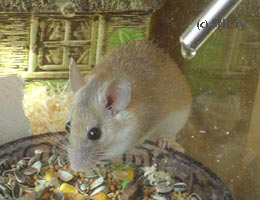
A spiny mouse having a dinner |
Nest
Spiny mice need a box or house for a nest. You can use your imagination with the nest box, as long as you remember that plastic parts are not safe, the spiny mouse toys should not have sharp edges and of course there should not be anything poisonous in them (paint, for example). There are several different alternatives available in pet shops; wooden, ceramic and plastic. The problem with wooden nest is that it soaks moisture. Ceramic nests are expensive, but they do last a lifetime - and not just your current spiny mouse's lifetime! Plastic ones can collect humidity inside the nest and spiny mice tend to chew holes in them. Splinters of plastic are not healthy for your pets if they happen to swallow them. You can construct a nest yourself as well. Earthenware flower pots make great nests and the spiny mice love them. Make a little hole in the side of a flower pot and turn the pot upside down. Be careful when making the hole, as the pots go easily into little pieces. Empty shell of a coconut is a good and fun nest too, especially if you hang it from the ceiling of the tank.
Do not give your spinies a wheel. It's a tail killer, as spiny mouse tail is quite fragile.
Other toys
Spiny mice love to have lots of toys around. All kinds of tubes and ladders are very popular among them. Ordinary toilet paper rolls are more than suitable for spiny mice. Biscuit and other small cardboard boxes are very suitable for mouse toys. You can attach several small boxes together and hide them under the beddings. Don't use glue, adhesive tape or metal to attach the boxes together, your spiny mouse might hurt itself. Just make a hole on the side of the box and stick a slightly smaller box a bit through that hole to attach the boxes together. Spinies will also chew on the boxes and make more and more little doors in them until the whole box is one big hole! Always remember to remove all plastic parts from the boxes.
Ladders can be bought ready made or you can make them yourself. Non poisonous branch of tree (willow, for example) from unpolluted area is also a nice toy to climb on.
Text: Satu Karhumaa, modified from original mouse article.
